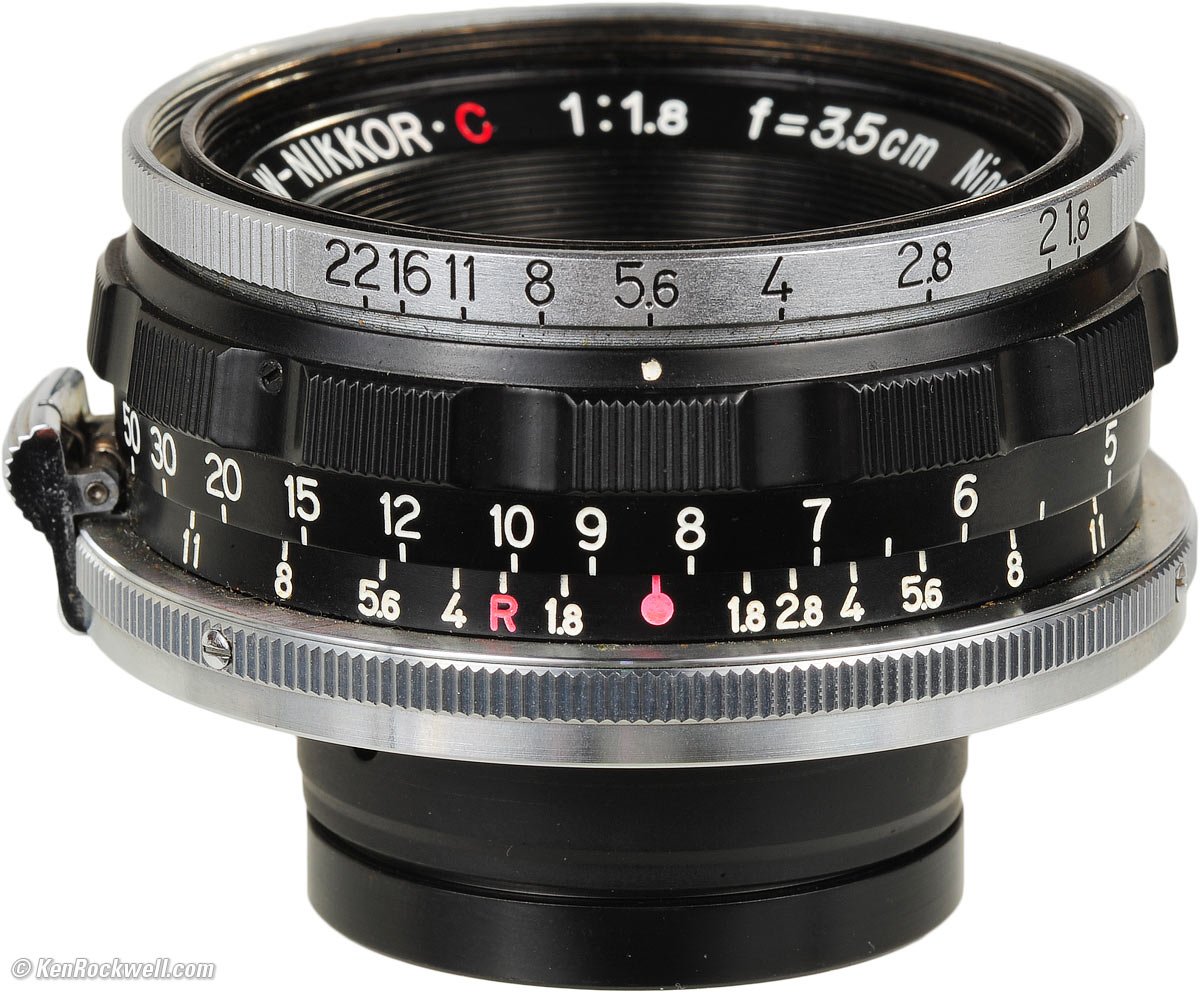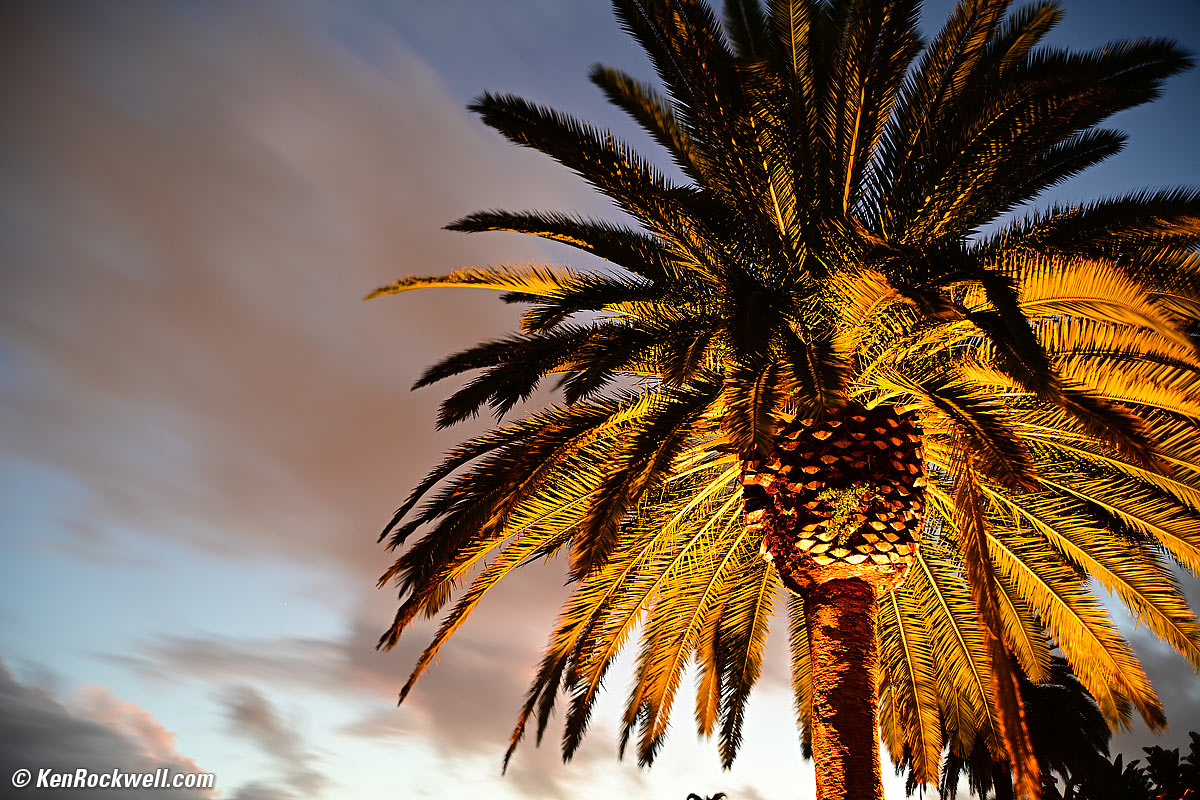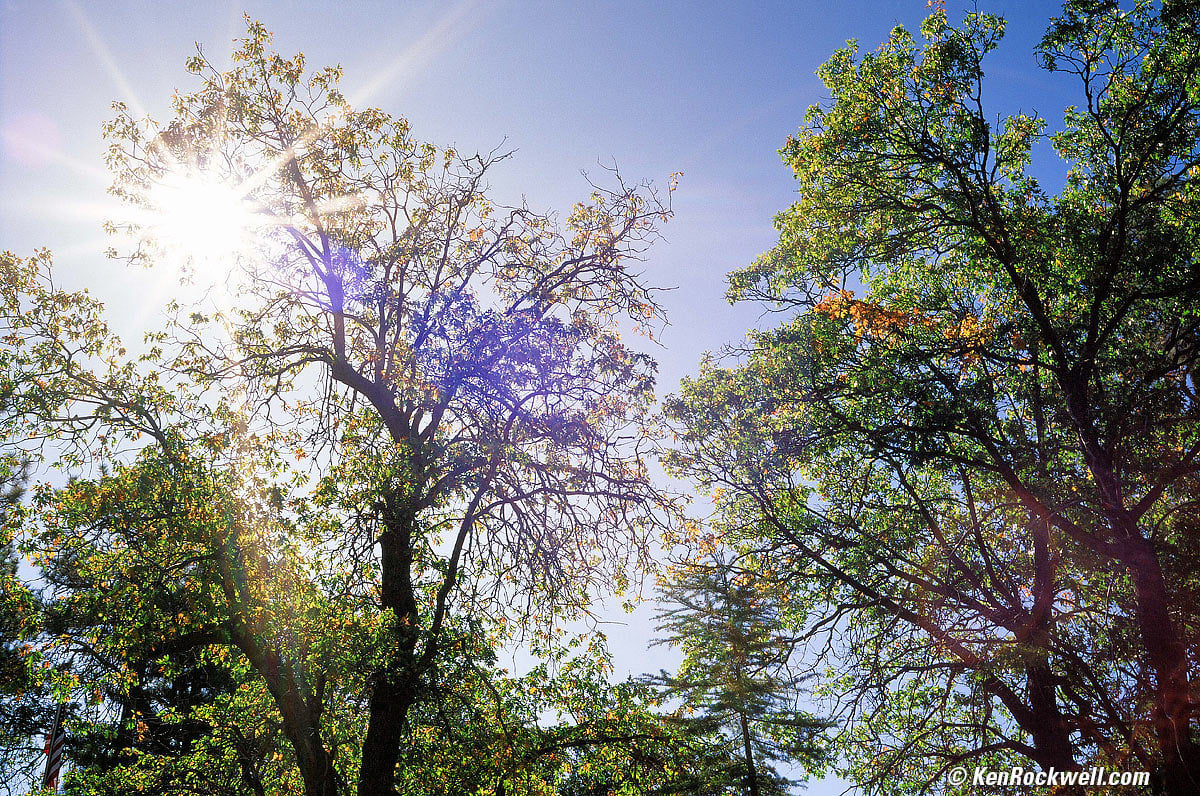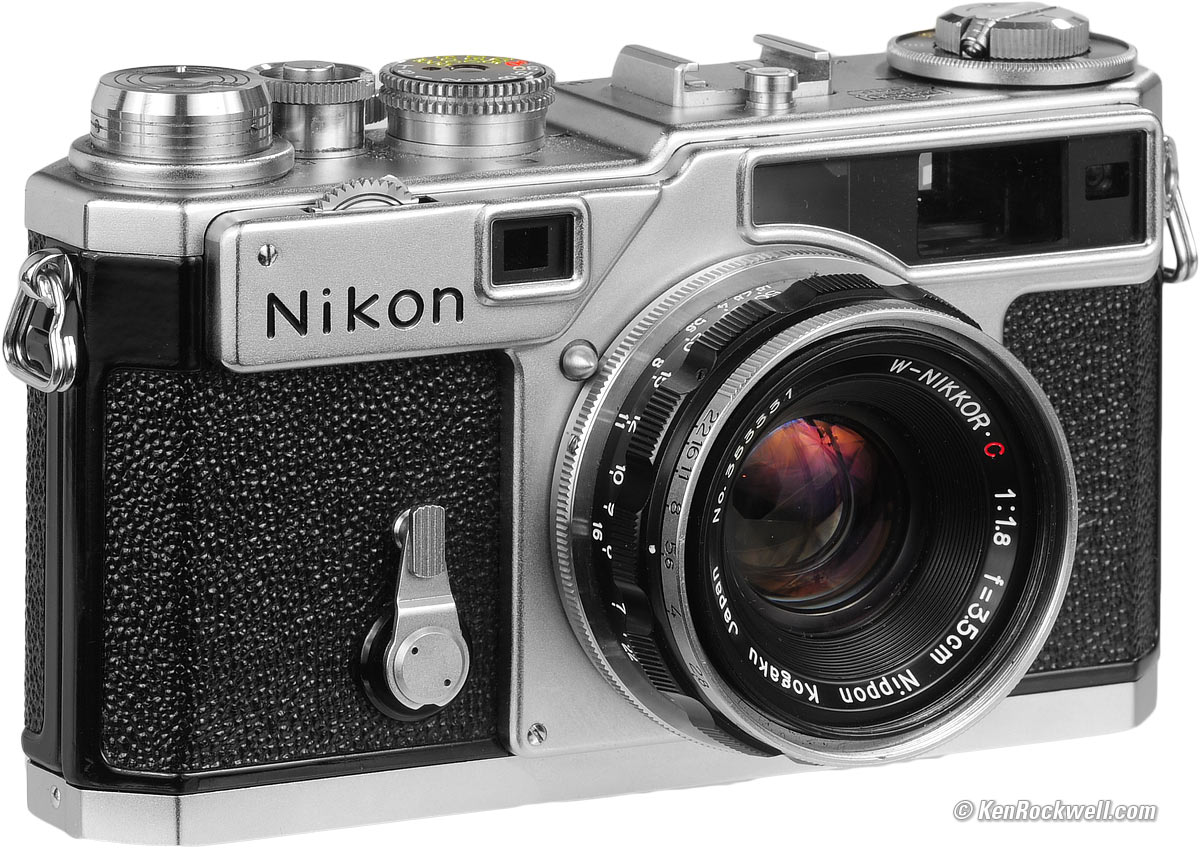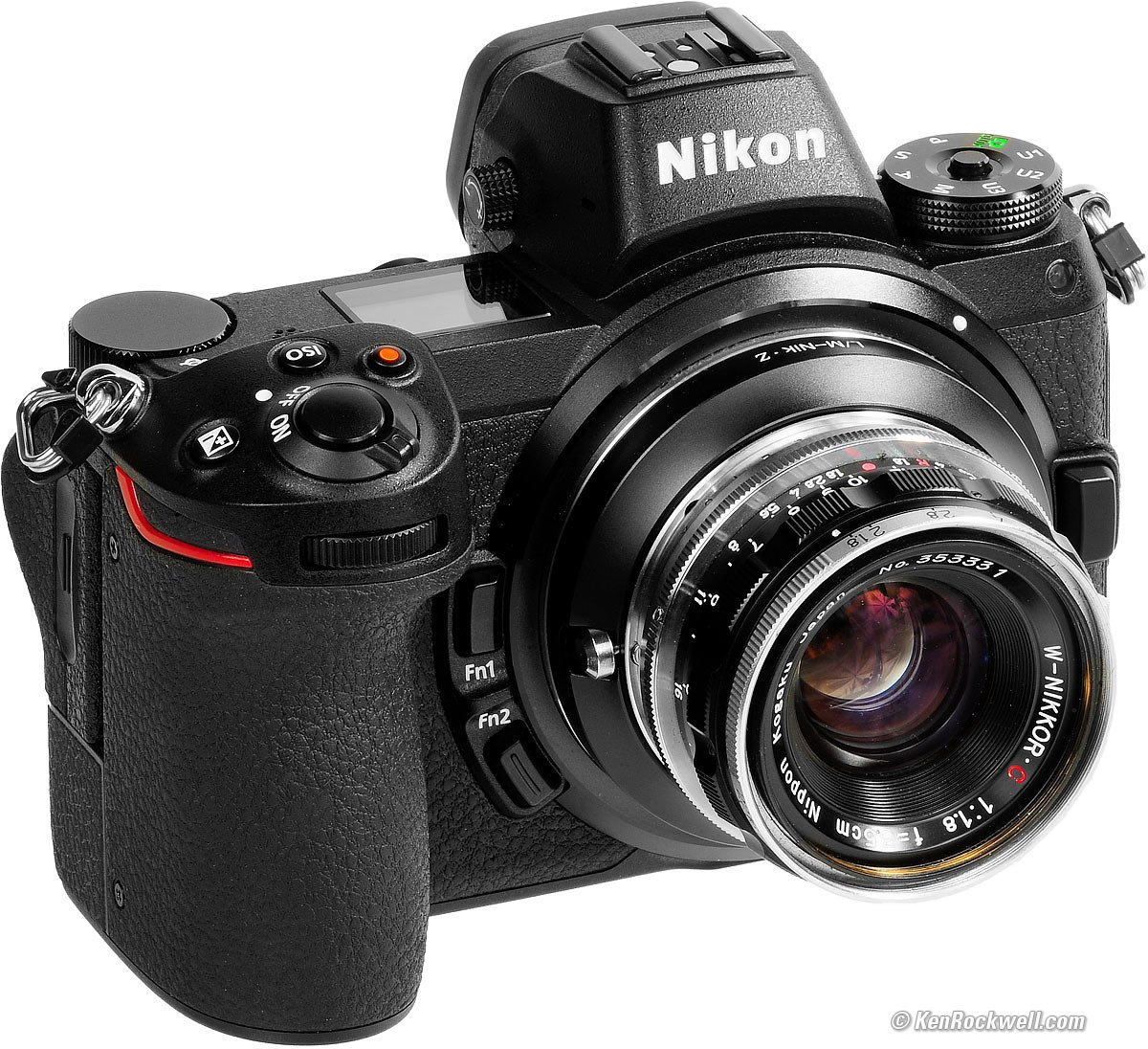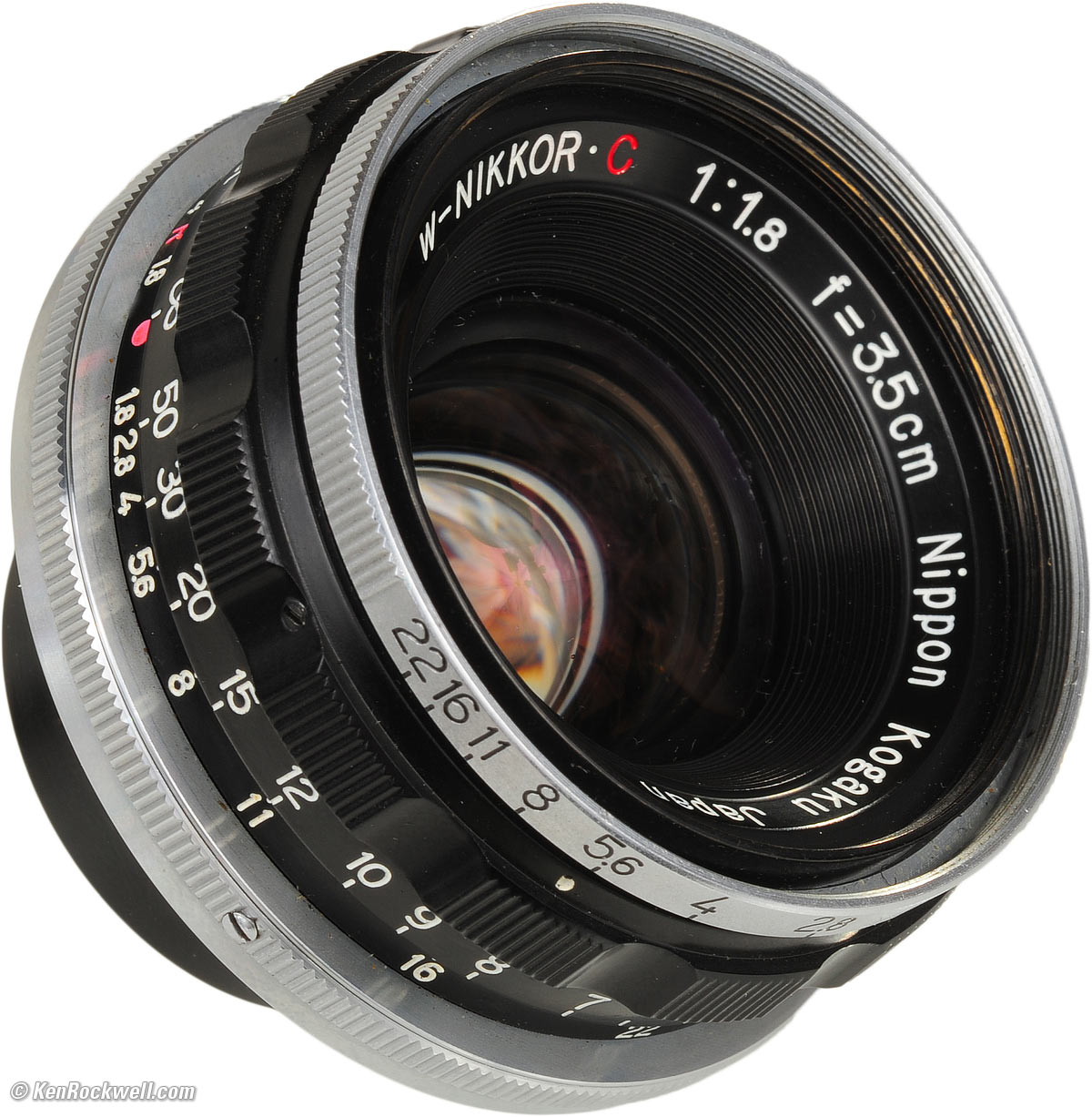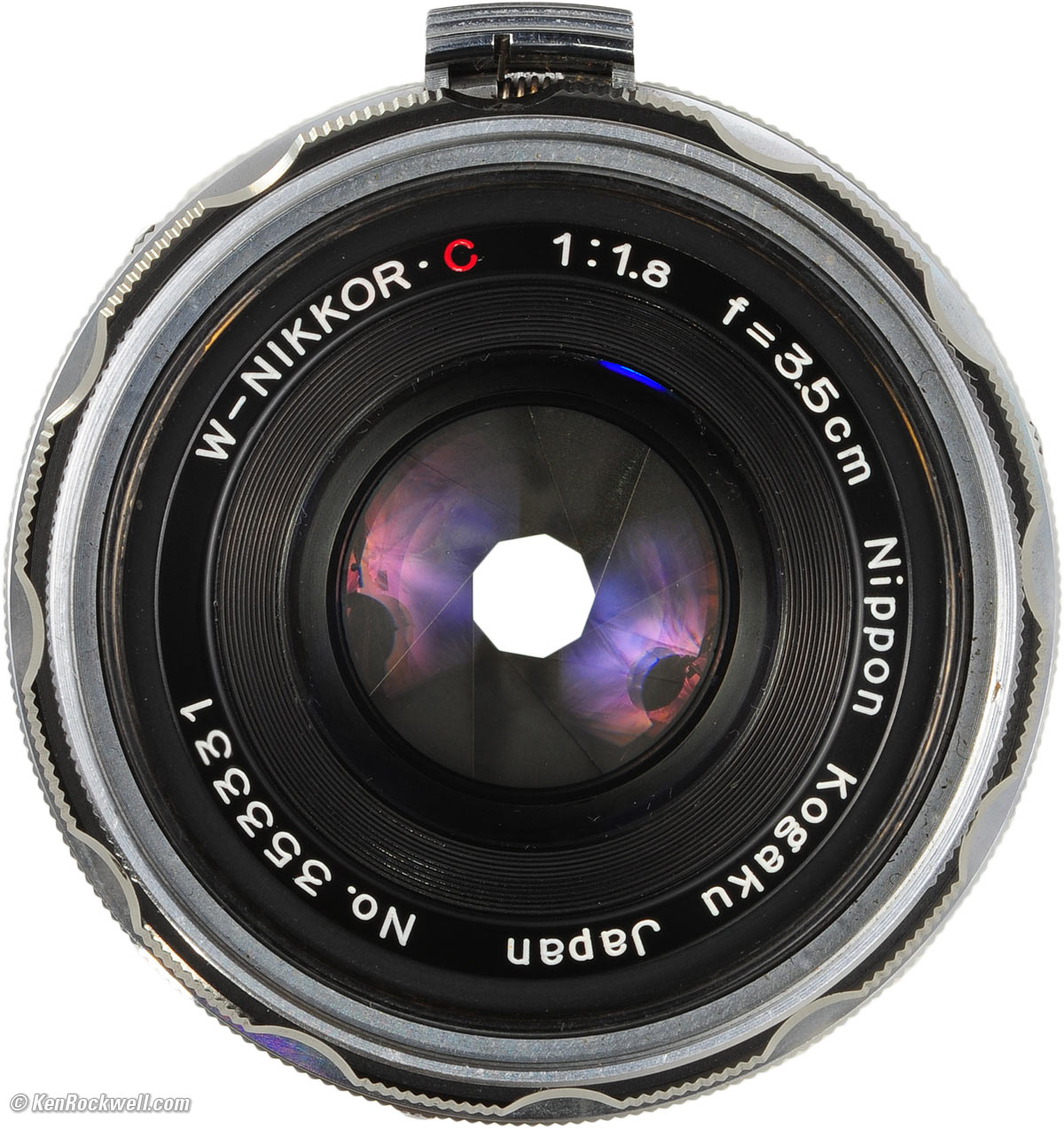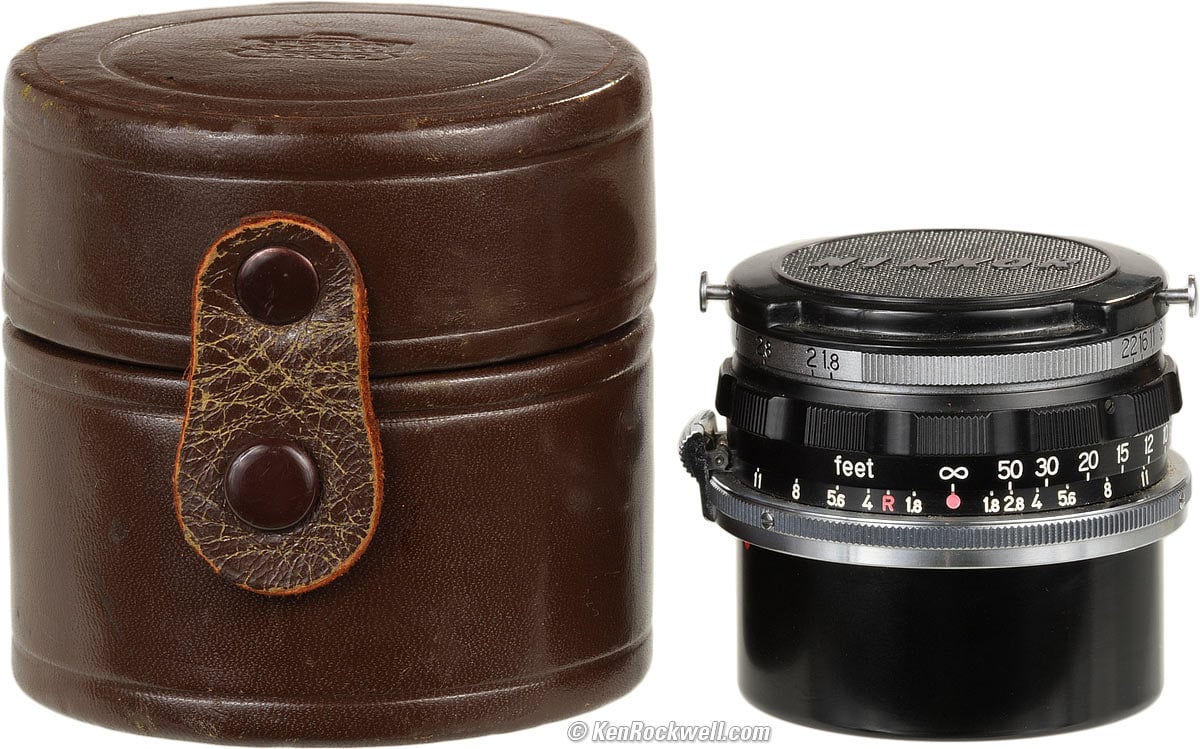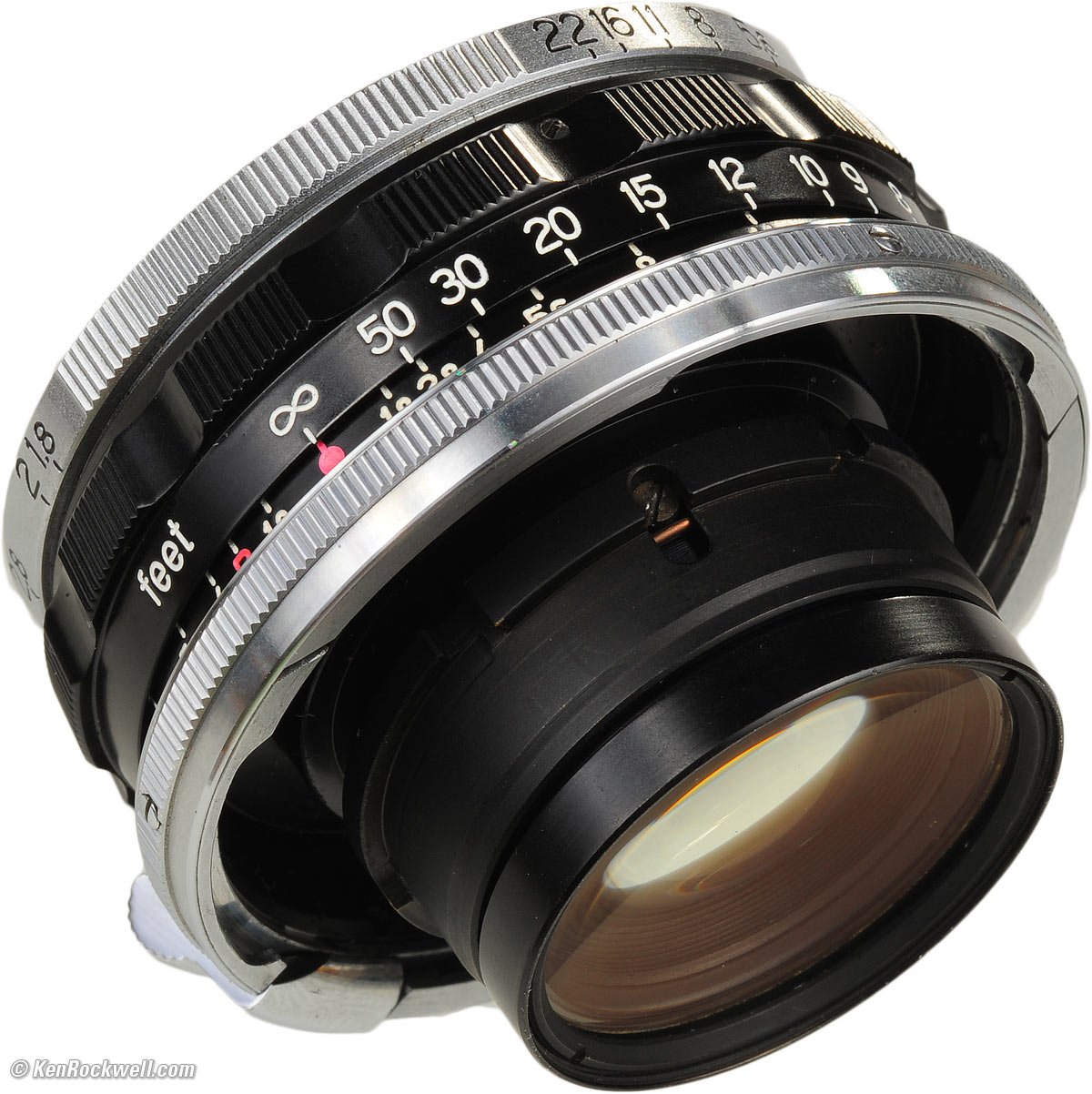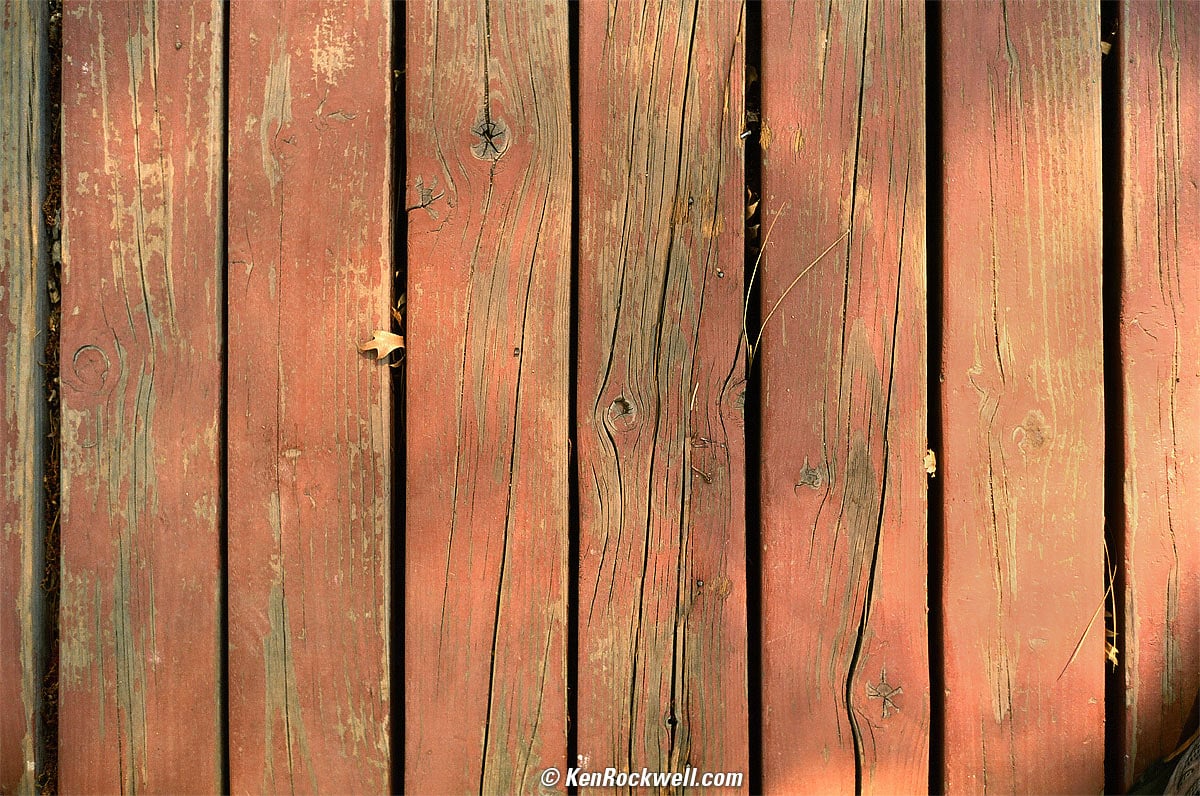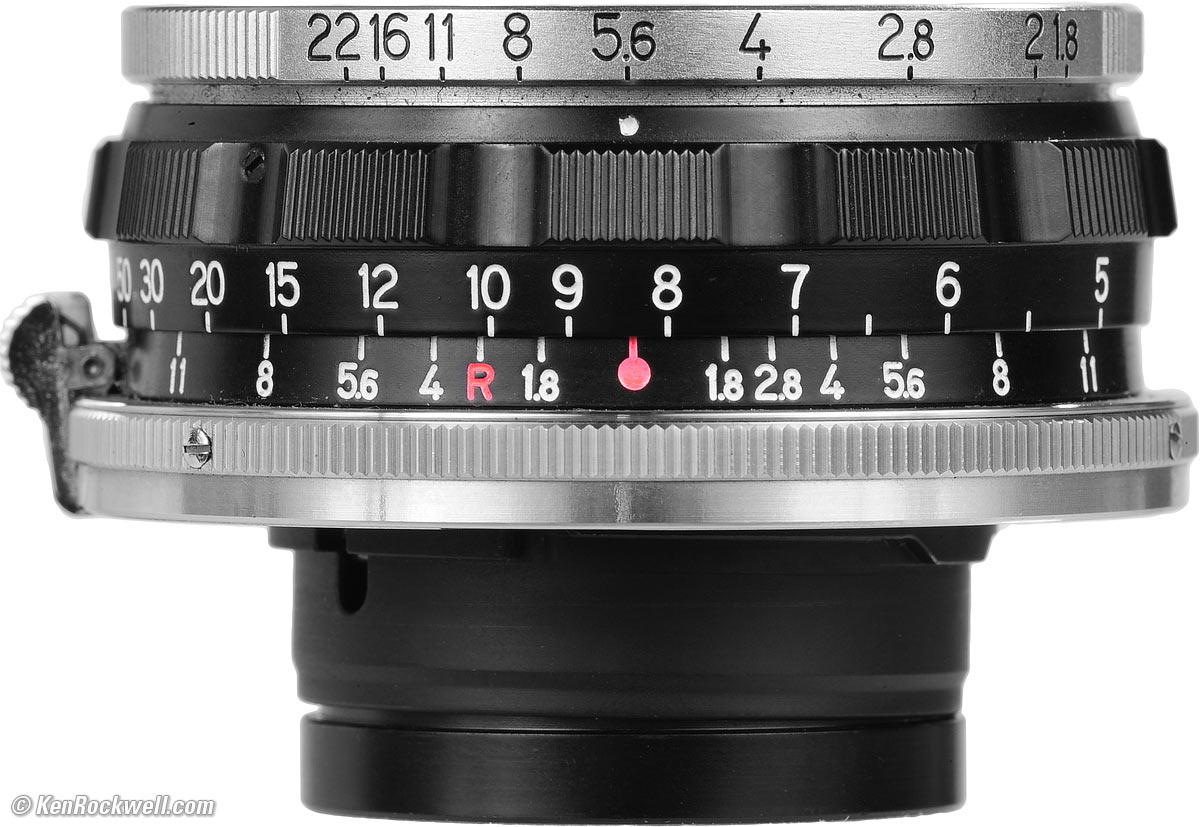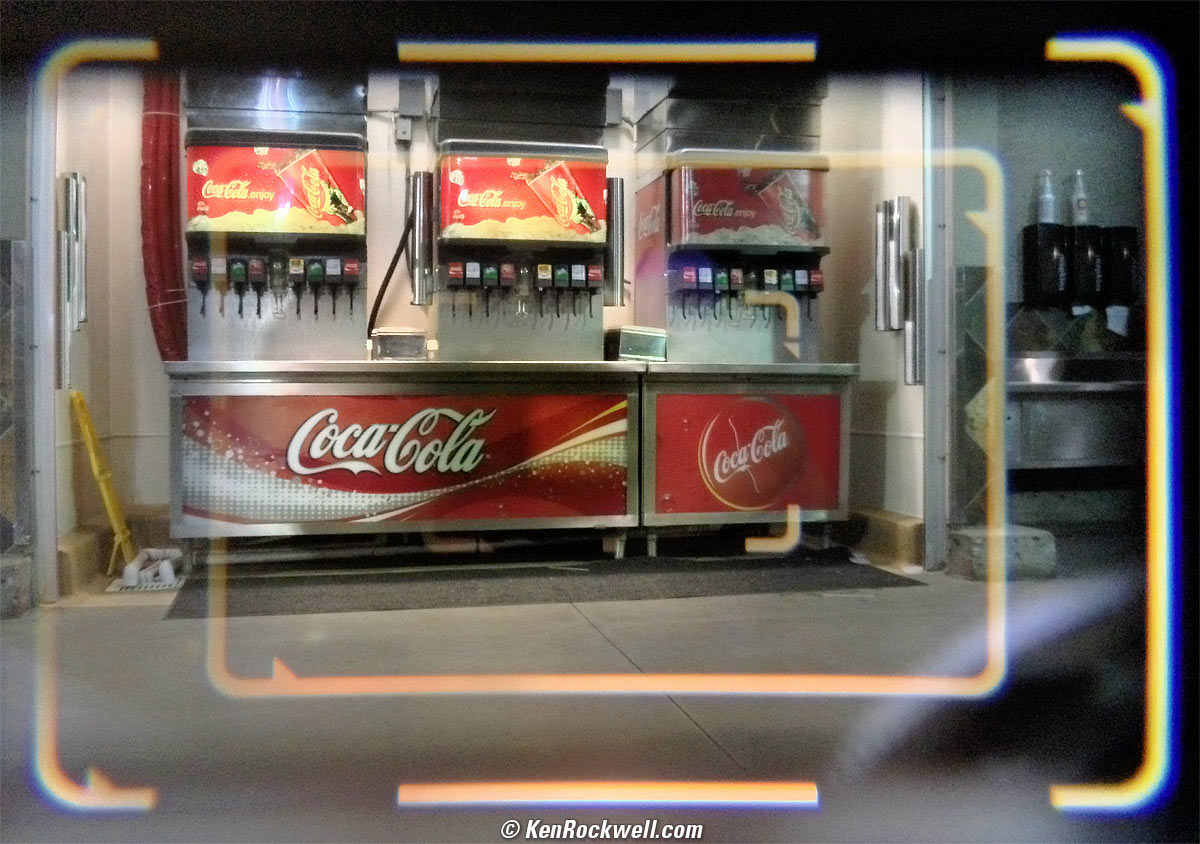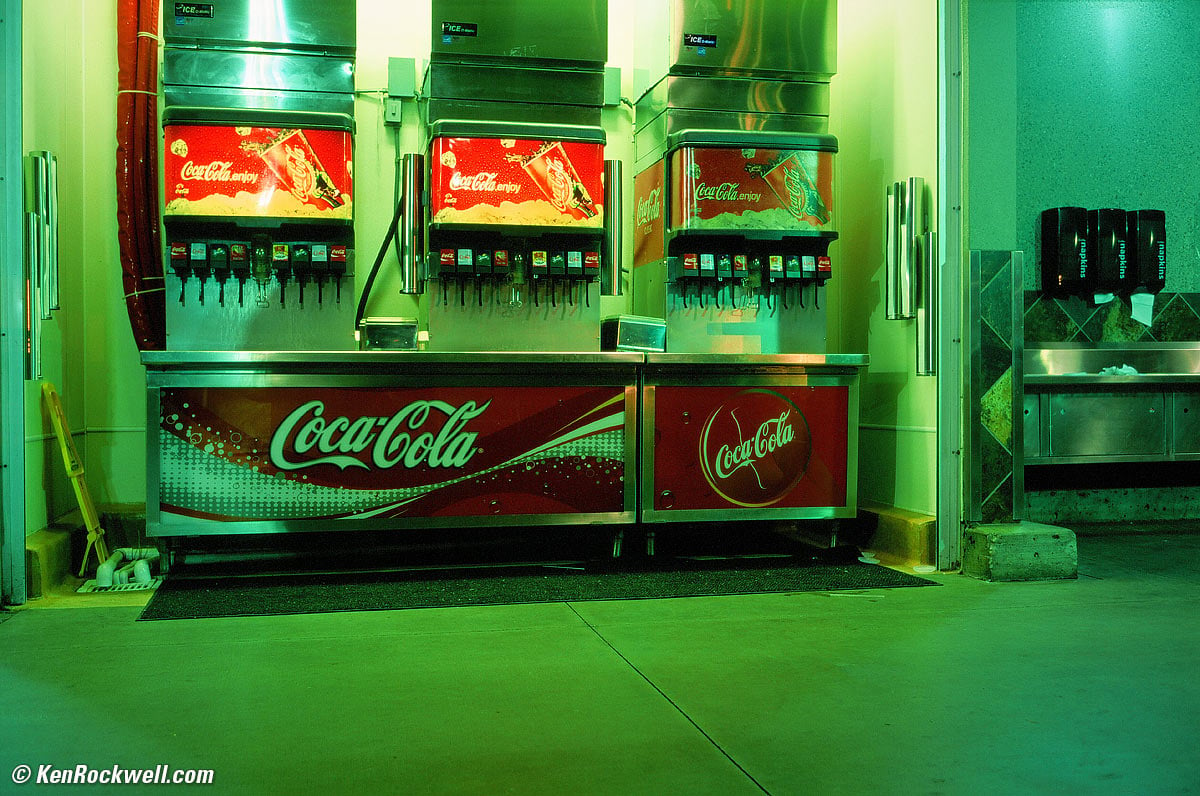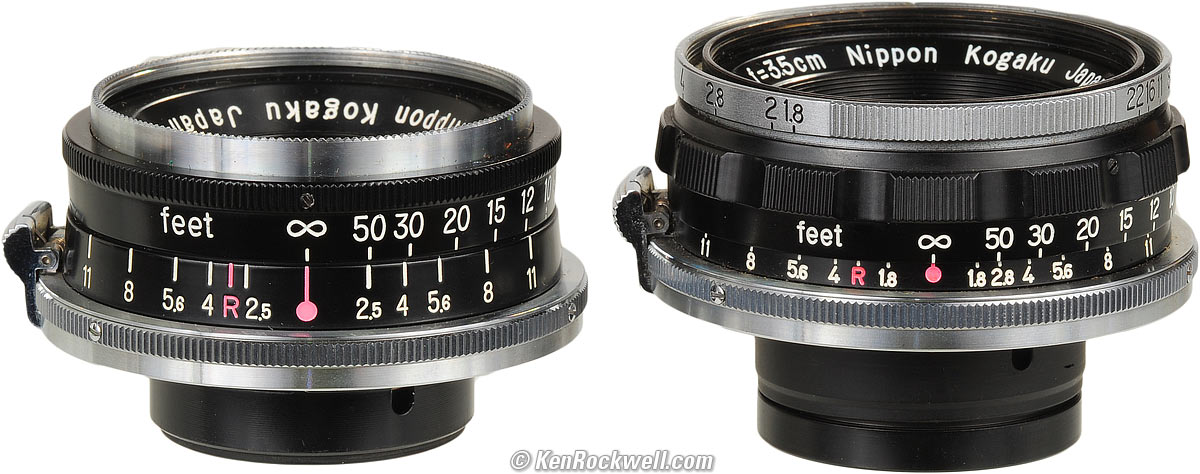Home Donate New Search Gallery Reviews How-To Books Links Workshops About Contact
Nikon 3.5cm (35mm) f/1.8
W-NIKKOR•C (1956-1964; 2005)
World's First Ultraspeed Wideangle
Intro Specs Performance Compared Usage Recommendations
Nikon W-NIKKOR•C 3.5cm (35mm) f/1.8 (43x0.5mm filters, 48mm thread for snap-on hood, 5.6 oz./160g, about $1,100 used if you know How to Win at eBay). enlarge. This free website's biggest source of support is when you use these links, especially this link directly to the Nikon 3.5cm f/1.8 at eBay when you get anything, regardless of the country in which you live. Thanks! Ken.
August 2022 Nikon Rangefinder System Nikon SLR System Nikon Mirrorless All Reviews
Sample Image Files
Palms and Storm, 6:21 PM, 29 November 2018. 2018 Nikon Z7 with 1956 W-NIKKOR•C 3.5cm f/1.8 (see Adapting Rangefinder Lenses to Nikon Mirrorless), f/4 at 10 seconds at ISO 64, shown exactly as shot. bigger or camera-original © file. The palm tree is blowing all over in the wind; don't expect it to be museum-sharp.
Palm, 19 January 2013. Nikon S3 - Year 2000 Edition, 1957 Nikon W-NIKKOR•C 3.5cm (35mm) f/1.8 with 43mm Hoya 81A, 1/60 at f/5.6 at 16 feet at 10:17 AM, Fuji Velvia 50, NCPS process and scan, Athentech Perfectly Clear plug-in. Full-Resolution 3,600 DPI scan.
Sun in Trees, Foster Lodge, 26 September 2009. 1/60 at f/9 at 75 feet on RVP50. Full-resolution image on Velvia 50 at 3,600 DPI (15 MB).
Introduction top
Intro Specs Performance Compared Usage Recommendations
|
I buy only from these approved sources. I can't vouch for ads below. |
The Nikon 35mm f/1.8 is the world's first super-speed wide-angle lens. It was an expensive professional wide-angle lens for Nikon's 1950s rangefinder cameras.
This old lens is more than twice as fast as any Nikon 35mm zoom lens ever made, and its sharpness and lack of distortion can exceed modern SLR lenses. This is because rangefinder lenses are designed without the compromise of having to avoid the flipping SLR mirror. Rangefinder lenses can get much closer to the film if the designer wants them to.
This 3.5cm lens is one of the good ones that was over-designed for its era, so it still performs wonderfully today.
It's a very small lens: the size of a golf ball weighing just 5½ oz. (160g), much less than any Nikon 35mm SLR lens and a tiny fraction of any Nikon zoom, the fastest of which is nowhere near as fast as this compact f/1.8.
Compatibility
35mm Film
It is not compatible with any Nikon SLR.
Nikon SP with Nikon 35mm f/1.8. bigger.
The Nikon W-NIKKOR•C 3.5cm (35mm) f/1.8 is only compatible with Nikon's S-mount rangefinder cameras.
It was also offered in LEICA screw mount, but LEICA shooters didn't care after LEICA introduced the extraordinary LEICA SUMMICRON 35mm f/2 in 1958.
This 1950s lens has nothing to do with today's plastic 35mm f/1.8 DX.
Digital
It is not compatible with any Nikon DSLR.
It is easy to find adapters to use it on Nikon's and other mirrorless cameras:
2018 Nikon Z7 with 1956 W-NIKKOR•C 3.5cm f/1.8. bigger.
History
1947-1964: f/3.5
Nikon's first 35mm lens for the rangefinder system was a much simpler and slower 3.5cm (35mm) f/3.5.
It's only a 4-element Tessar, and probably not a particularly great performer in the corners for a lens this wide.
Nikon made about 20,000 of these in various cosmetic variations.
1952-1964: f/2.5
Nikon made about 25,000 copies the excellent 6-element 3.5cm (35mm) f/2.5.
It came in various cosmetic variations to induce people to buy new versions, even though they were all the same optically.
1956-1964: this f/1.8 lens
This f/1.8 lens was a show-off lens from Nikon, the world's fastest wide-angle lens.
The first few dozen had black-painted aperture rings, quickly upgraded to chrome rings as seen here for the majority of lenses.
Nikon made about 7,000 of these f/1.8 super-speed lenses.
Nikon was promptly shooed out of the rangefinder business by LEICA, who introduced an optically and ergonomically superior LEICA SUMMICRON 35mm f/2 in 1958, and the new world's fastest 35mm lens, the LEICA SUMMILUX 35mm f/1.4 in 1960.
2005: f/1.8 Special Edition
Nikon made about 2,500 "special edition" copies of the 3.5cm f/1.8 to sell with their remake of the Nikon SP special edition, both announced 14 January 2005. They were sold only factory-direct by lottery in Japan and sold-out by May 2005.
Catalog price of the SP special edition and this lens was 690,000 yen (about $6,700 at the time). They were only sold together as a kit.
The 2005 edition is identified by:
1.) Four-digit serial number from 0001 through about 2,500. Originals have six-digit serial numbers starting around 351,801. This is all you really need to check, a 4-digit versus 6-digit serial number.
2.) Black aperture ring on 2005 version.
3.) Meters-only focus scale. Original lenses were in feet for the USA and meters for elsewhere.
4.) Coarse 43 × 0.75mm filter thread on the 2005 version, not the fine 43 × 0.5mm thread of the original.
5.) New lens is multicoated in green; original is single-coated in blue and amber.
6.) Different font for engraved markings. Look at the "g" in "Kogaku" and the digit "3" as used in the serial numbers:
6a.) The original lens uses a "g" with two loops, while the 2005 edition has only a curved descender as seen in the Helvetica "gs" in the text on this page. (Newer versions of the original lens from about serial number 355000 also use the newer style g.)
6b.) The original "3s" in the serial number have a straight top, while the "3s" of the 2005 version look like the all-curved Helvetica 3s you see here. The 3s on the focus scale were all round in the original version, too. (Newer versions of the original lens from about serial number 355000 also use the newer style 3 everywhere.)
6c.) The tops of the "1s" of the original version curve down, like an Arial "1," while the 1s of the 2005 edition have tops that poke straight out, like a Futura "1." (Newer versions of the original lens from about serial number 355000 also use the newer style 1.)
Nikon W-NIKKOR·C 3.5cm f/1.8. enlarge.
Specifications top
Intro Specs Performance Compared Usage Recommendations
Name
Nikon (Nippon Kogaku) calls this the W-NIKKOR·C 3.5cm f/1.8.
"W" means wide.
NIKKOR is Nikon's brand name for its lenses.
Like all Nikon rangefinder lenses, these first versions were marked "C" to denote "coated," which was advanced technology for 1952.
The "C" was dropped in about 1957, at which time all competitive lenses were coated, too.
Focal Length
35mm (3.5cm).
Angle of View
63º diagonal.
53º horizontal.
37º vertical.
Optics
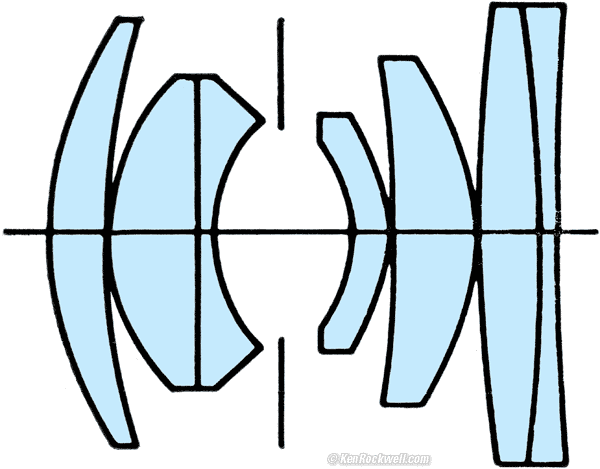
Cross-section, Nikon W-NIKKOR•C 3.5cm (35mm) f/1.8.
7 elements in 5 groups.
Rare-Earth Lanthanum glass, which is radioactive! In 2018 my lens still measures 0.1 mR (1 µSv) per hour with the lens sitting on my Geiger counter. This glass can yellow over time, which if it does usually leads to better pictures, and if you don't like it I hear that leaving the lens exposed to ultraviolet light (direct sunlight) will clear it.
Single-coated in blue and amber.
Modified double-Gauss.
This design, with the much larger rear section, was used as inspiration for the lens of the Konica Hexar, however the Hexar is slower (only f/2) and has much more distortion than this W-NIKKOR•C.
Marketing poopla pitched "extremely large front and rear elements, sufficient for f/1.4, decreases vignetting," but these elements are simply normal size for a wide 35mm f/1.8 lens. All 35mm focal-length (wide-angle) lenses for rangefinders are supposed to have more falloff due to the cos4 law and lack of retrofocus design. Nikon was simply using FUD and the normal characteristics of wide-angle rangefinder lenses to scare people into thinking that this lens was something special. It is special, but not as far as vignetting is concerned.
Diaphragm
Nikon W-NIKKOR•C 3.5cm (35mm) f/1.8 at f/5.6. enlarge.
9 straight blades.
Full-stop clicks to f/22.
Close Focus Distance
3 feet (0.9m).
Filter, Hood and Cap Threads
The Nikon 35mm f/1.8 has two sets of threads: a 43x0.5mm thread on the inside for filters, and an outer 48mm thread for the hood and/or cap.
Filter Thread
43mm, 0.50mm pitch (43E).
Newer filters are 0.75mm pitch, (43ES), so watch it: do not force a filter onto the lens. A new 43mm filter will seem to fit, then bind after you've screwed it in a turn or two. Don't push it any farther.
The filter thread is a real helical thread.
Cap and Hood Thread
The cap and hood mounting threads aren't real 48mm helical threads, they are just ribs onto which the hood and/or cap can grip firmly.
They are the aperture ring, so of course they rotate as the aperture is changed.
Hood
AC-521 reversible snap-in hood.
It sold for the equivalent of $40 ($4.75 in 1956 dollars).
Just like Nikon's caps of the era, the hood had two tits which were pressed to compress a threaded "C" ring to hold onto the 35mm lens' outer set of 48mm threads.
Nerds have hoarded this hood, so use something different.
Case
Nikon 35mm f/1.8 and case and caps. enlarge.
Genuine leather hard padded case with full-grain leather snapper holder and fuzzy royal purple velvet on the inside.
Front Cap
Plastic cap with threaded metal C-ring compressed with two tits for mounting and unmounting.
Rear Cap
"WW" type AC-593 outside bayonet rear cap.
Originally metal as shown here, Nikon cheapened them to plastic in later years.
Mounts
Nikon S rangefinder, external bayonet.
LEICA screw mount (uncommon; LEICA shooter know better).
Size
1.560" long by 2.198" diameter (39.62 x 55.83mm) overall, measured, excluding the bayonet release.
Even though there is a focus helicoid, the overall length doesn't change because the lens pokes out both the front and rear of the mount.
Weight
5.645 oz. (160.05g), measured.
6.385 oz. (181.0g), measured with caps.
5 ½ oz., rated.
6 ⅜ oz., rated in LEICA screw mount.
Design Completed
Winter 1955.
Announced
June 1956.
First Sold
September 1956.
Price
August 2022
About $1,100 used if you know How to Win at eBay.
2011, 2018
Catalog price (corrected for inflation in 2011) was $1,500 in 1956. Actual selling price was discounted probably to about $1,400 equivalnt. (in 1956 dollars, this was $179.95 and $169, respectively.)
Original catalog price in Japan was 39,500 yen (in 1956 yen).
In 2011, used ones sell for about $700. If they include the case and both caps expect to pay more.
Rear, Nikon W-NIKKOR·C 3.5cm f/1.8. enlarge.
Performance top
Intro Specs Performance Compared Usage Recommendations
Overall Color Balance Distortion Ergonomics
Falloff Focusing Hood Lateral Color Fringes
Mechanics Sharpness Sunstars Survivability
Overall performance top
The Nikon 3.5cm f/1.8 is an excellent lens, outperforming today's SLR lenses like the 35mm f/2 AF-D. It has superb sharpness and no visible distortion. It is faster and has less distortion than the newest 24-70mm f/2.8 AF-S.
That's all fine and dandy, but this is a lens for a camera system which photographers have ignored since the late 1950s.
Today, you'd have a far easier time shooting with the equally excellent 35mm f/2.8 lens of the Nikon 35Ti.
If you want the best performance, the contemporary LEICA SUMMICRON 35mm f/2 is sharper and even better made. These are some of the reasons that even though Nikon rangefinder equipment sold for about 15% less than LEICA in the 1950s, LEICA still outsold Nikon 10:1.
Color Rendition performance top
Color balance of the sample seen here is warmer than my other lenses, almost as strong as an 81A or A2 filter.
Distortion performance top
Old Wooden Walkway, Foster Lodge, 26 September 2009. 1/60 at f/3.1 at 3.5 feet on RVP50. bigger.
There is no distortion, even under the microscope. Scanned at 3600 DPI, shown at 200% and scrolled back and fourth against a snap line on my 30" monitor, there is no distortion. This lens has much less distortion than the old walkway does.
Measured Distortion versus Distance
50' (15m) |
0.0 |
10' (3m) |
0.0 |
5.5' (1.7m) |
0.0 |
© 2011 KenRockwell.com
This is one of the advantages of rangefinder camera systems and the symmetrical design of this lens. Wide lenses easily can be designed with no distortion for rangefinder cameras, while SLR and zoom lenses have to go through optical gyrations that add distortion (retrofocus design) to keep the rear elements away from the flipping SLR mirror.
Ergonomics performance top
Nikon W-NIKKOR·C 3.5cm f/1.8. enlarge.
Ergonomics of the lens are great: easy focus, and easy aperture setting.
It's easy to grab the larger silver ring for mounting and unmounting.
The aperture ring rotates with focus, and there are two sets of identical scales.
The matte-silver finish aperture ring and black-and-white distance scales are always easy to read in any light.
The lens' ergonomics are great, but the Nikon Rangefinder Cameras are a different story.
On most Nikons, you'll need to focus through one window, and move your eye to a different window or external finder to frame. If you or the subject move, you have to start the whole process over again from scratch.
The Nikon S3 is ideal for use with this lens, since the main viewfinder window is both 100% life-sized, covers this 35mm lens, and allows focus as well.
Viewfinder view with Nikon S3. Subject at 17 feet. Note lens incursion in lower right. Dark top caused by the way I photographed this view; it looks much better by eye.
Resultant image, Coke Machines, 19 January 2013, 6:39 PM. They're green because that's the way mercury lights register on daylight film. (Nikon S3 - Year 2000 Edition, 1957 Nikon W-NIKKOR•C 3.5cm (35mm) f/1.8 with 43mm Hoya 81A, 1 second at f/3.5 at 17 feet, braced on table by hand, Fuji Velvia 50, NCPS process and scan, Athentech Perfectly Clear plug-in.) bigger.
No Nikon Rangefinder Camera has ever offered automatic parallax correction for any 35mm lens.
On most Nikon Rangefinder Cameras you will need an external viewfinder because no Nikon 35mm lens has the auxiliary finder optimization optics of LEICA's contemporary 35mm lenses.
Falloff (darkened corners) performance top
As expected, there is some normal mechanical vignetting (falloff) at f/1.8.
It's almost gone at f/2.8, and completely gone by f/4.
Even at f/1.8 on contrasty slide film (RVP50), any falloff even at f/1.8 is insignificant.
Focus performance top
This is one of the areas in which rangefinder cameras excel.
The rangefinder of any camera system has to be accurate and precise enough for use with the fastest and longest lenses of that system.
This 35mm f/1.8 lens is short enough that even a legally blind person probably can get great focus. You can be way off in the viewfinder, and still be dead-on on film because the Nikon camera's rangefinder system is so precise.
Hood performance top
The hood for this 35mm lens has been hoarded by nerds, so it's difficult to find.
A much better solution is to use the common hood for the 5cm f/1.4, which works fine and even gives better shielding than the correct hood.
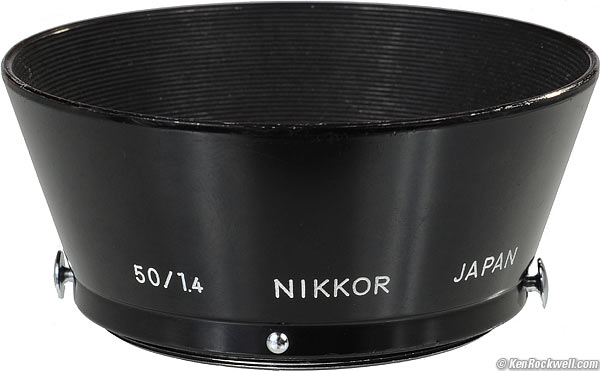
43mm snap-in hood for Nikon 5cm (50mm) f/1.4.
There can be a very slight bit of the corner of the full-gate on-film image slightly darkened at some settings, but I doubt that it would ever be noticed in actual use where we rarely print full-frame (negative holders usually crop the edges where any darkening would be confined).
Lateral Color Fringes performance top
I see none, which is superb performance.
Mechanics performance top
It's all metal and all markings are engraved.
The focus glides without any play.
Magnificent!
Sharpness performance top
On Fuji Velvia 50, it's super-sharp.
The biggest detriment to sharpness is some curvature of field, which curves-in the surface of best subject sharpness closer to you at the sides.
At f/1.8, the far sides get a little softer due to coma flare, but overall, your biggest challenge its trying to get your subject in perfect focus all across the field, not this lens' sharpness.
By f/4, it's super-sharp even in the corners.
Sunstars performance top
Sun in Trees, Foster Lodge, 26 September 2009. 1/60 at f/9 at 75 feet on RVP50. Full-resolution image on Velvia 50 at 3,600 DPI (15 MB).
The straight 9-bladed diaphragm makes great 18-pointed sunstars on brilliant points of light.
The blades appear to be cut with a non-square edge, so the 18 points aren't quite symmetrical.
Survivability performance top
These lenses are already 50 years old.
There is nothing to break or wear out. It's all metal.
Nikon's old lenses don't get foggy or seize up as do old LEICA lenses.
The worst I've seen is some slight oil on the blades of some samples, but so what: all that does is help the blades last an extra 500 years.
If you get a sample that needs service, I'd send it to Gus Lazzari for an overhaul, but even lenses that have been beaten around probably still work great.
Compared top
Intro Specs Performance Compared Usage Recommendations More
Nikon W-NIKKOR·C 3.5cm f/2.5 and W-NIKKOR·C 3.5cm f/1.8. enlarge.
If you can afford it, this f/1.8 lens is the best for Nikon rangefinder cameras because it's at least as sharp as the f/2.5 and f/3.5 lenses at every aperture, has no distortion, is easy to set apertures on its dedicated external ring, isn't much bigger than either of the other lenses, adds an extra stop or two of speed and has a magnificently unique 9-bladed diaphragm for great sunstars.
If money matters, the 3.5 cm f/2.5 lens is just as sharp.
I have not tried the f/3.5 lens.
The numbers don't seem like it, but f/3.5, f/2.5 and f/1.8 are exactly one stop away from each other.
The Nikon 28mm f/3.5 has much poorer performance than this 35mm lens.
The LEICA SUMMICRON 35mm f/2 of 1958 has much better performance. It also has no distortion, but has much less coma and is much sharper, especially in the corners, than this Nikon lens.
Usage top
Intro Specs Performance Compared Usage Recommendations More
Focusing Framing Mounting Unmounting Stowage
Turn the lens' focus ring, or the camera's own focus wheel (the sharply toothed wheel in front of the shutter release).
On the Nikon SP, focus by looking through the main finder window.
Framing and Composition usage top
On the Nikon SP, peep through the little finder just to the left of the main finder. Use the frame lines there. If you're very close, use the inside set of frame lines, otherwise use the bigger one.
Be sure to focus through the main finder, but move your eye a fraction of an inch (1cm) to the left to compose.
Is there any wonder why the LEICA M3 sold ten times as many cameras, even though it cost more? On the M3, you can focus and frame 35mm lenses through the same window, complete with automatic parallax correction. For Nikon to win against LEICA, Nikon had to change the game to SLRs like the Nikon F.
Set both the lens and the camera to infinity (∞).
Line up the red focus index dot on the lens with the big red dot on the camera body.
Gently push the lens straight in.
Rotate the lens' silver mounting ring counter-clockwise until it clicks into position.
Twist the lens' focus ring back and forth a little to be sure it's locked to the camera's focus system.
Press the lens' release button (the big knob on the side) towards the center of the lens.
Rotate the lens' mounting ring clockwise until the lens' focus index is by the big red dot on the camera body.
Lift straight out.
Nikon 35mm f/1.8 and case and caps. enlarge.
The front cap locks on (press the chrome tabs), and the rear metal cap is a bayonet. Pop it in the small Corinthian leather case (2.97" tall by 2.97" diameter (75.5 x 75.5mm) and off you go. The case is smaller than most SLR lenses: it's too small to need any attachments for straps.
The rear cap is a work of art. It's enameled stamped metal with an inset and painted red dot. Nikon got cheaper later in the 1950s and downgraded to plastic rear caps.
Recommendations top
Intro Specs Performance Compared Usage Recommendations
Need a 35mm lens for your Nikon Rangefinder camera?
This 35mm (marked as 3.5cm) f/1.8 is the best there is.
Help me help you top
I support my growing family through this website, as crazy as it might seem.
The biggest help is when you use any of these links to Adorama, Amazon, eBay, B&H, Ritz, Calumet, J&R and ScanCafe when you get anything. It costs you nothing, and is this site's, and thus my family's, biggest source of support. eBay is always a gamble, but all the other places always have the best prices and service, which is why I've used them since before this website existed. I recommend them all personally.
If you find this page as helpful as a book you might have had to buy or a workshop you may have had to take, feel free to help me continue helping everyone.
If you've gotten your gear through one of my links or helped otherwise, you're family. It's great people like you who allow me to keep adding to this site full-time. Thanks!
If you haven't helped yet, please do, and consider helping me with a gift of $5.00.
As this page is copyrighted and formally registered, it is unlawful to make copies, especially in the form of printouts for personal use. If you wish to make a printout for personal use, you are granted one-time permission only if you PayPal me $5.00 per printout or part thereof. Thank you!
Thanks for reading!
Mr. & Mrs. Ken Rockwell, Ryan and Katie.
Home Donate New Search Gallery Reviews How-To Books Links Workshops About Contact
12 Aug 2022, 30 Nov 2018, Jan 2013, May 2008
07 Sept 2010 under 50/2
26-28 Sep 2009 - Foster Lodge
19 Sep 2012 Ryan and Legoland RVP50 ?

